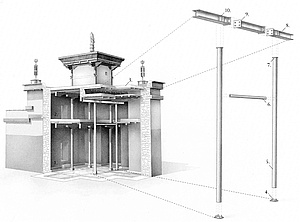
The Swiss foundation, “THE ACHI ASSOCIATION”, is dedicated to the research and maintenance of sacred monuments belonging to the Drigung-Kagyu order in Northern India. Back in 1998, TU Graz was commissioned to research five temples in Ladakh. The 700-year-old three-storeyed Wanla Temple was built according to a mandala plan. The temple’s masonry is made of local stone material bonded with clay mortar, and its interior walls are painted throughout. The roof constructions are traditional clay roofs. In the course of the centuries, additional layers of clay were applied to the roof to prevent moisture penetration, leading to an enormous increase in the construction’s roof load (causing broad cracks in the interior). In 2004, test excavations and a material analysis were undertaken as to the roof structure. Work carried out in 2005 and 2006 has relieved a load of over 10 tons on an area of approximately 24m²! The new uppermost roof layer was applied in an optimised traditional form and equipped with a new insulation and drainage system. Investigations in 2006 showed that those parts of the roof which are over one metre “thick” had a “double roof construction” that had been added later on. Large parts of that have since collapsed, thus putting the original ceilings under pressure. 2007: renovation of the roof above the veranda; elaboration of a renovation concept for the double roofs. In 2008, the double roof was renovated by inserting a double aluminium 3-truss girder construction which bears a new clay roof. In 2009, structural measures were performed on the inner supporting constructions to prevent them from drifting apart (stabilising structures offering control function). In the following year, work was carried out to secure the lantern. In 2011, further investigations were conducted on “the step-by-step erection of a three-storeyed temple” (“heritage monuments puzzle”). Finally, in 2012, a building survey of the “ground floor” was carried out on the forecourt and in 2013, additions were made to the roof constructions for the banners (Dugs).
Project duration:
2004 ─ 2014
Project management:
Institute of Architecture Technology, TU Graz
Wolfgang Heusgen
Roland Pabl
Financing:
Achi Association, Schweiz
Project duration:
2004 ─ 2014
Project management:
Institute of Architecture Technology, TU Graz
Wolfgang Heusgen
Roland Pabl
Financing:
Achi Association, Schweiz
